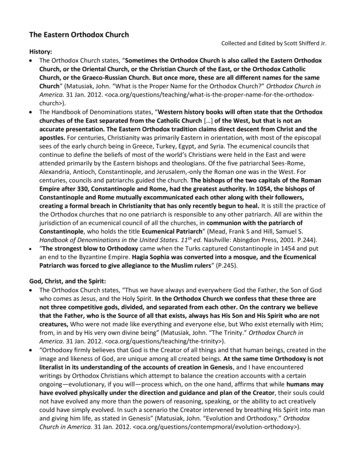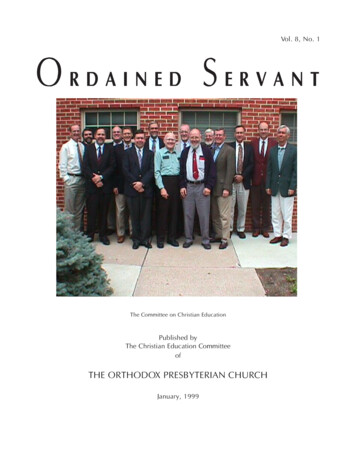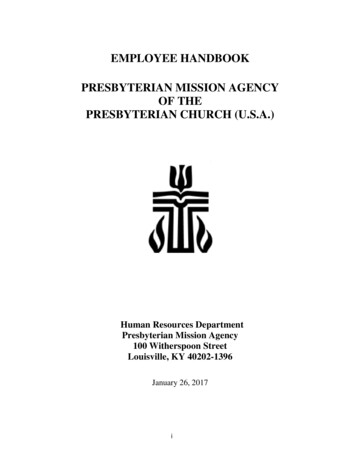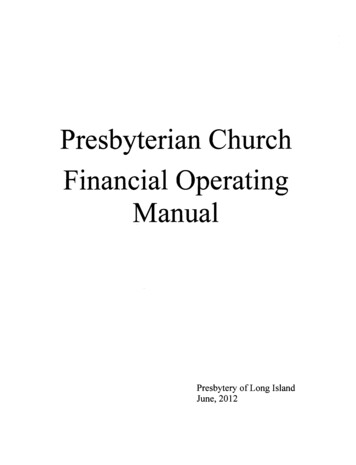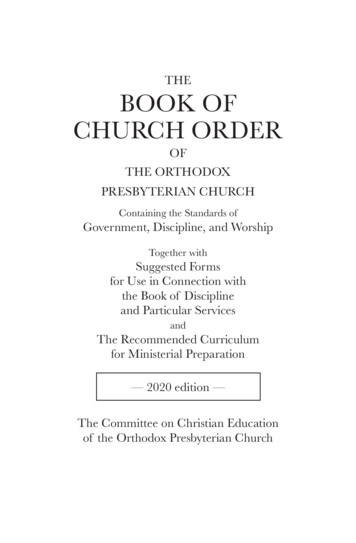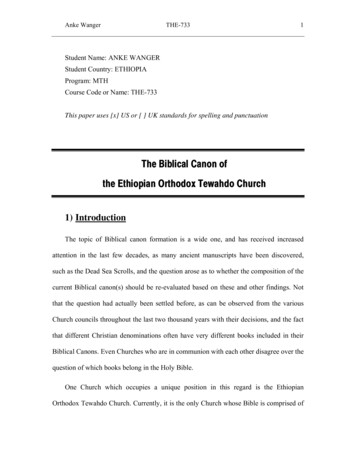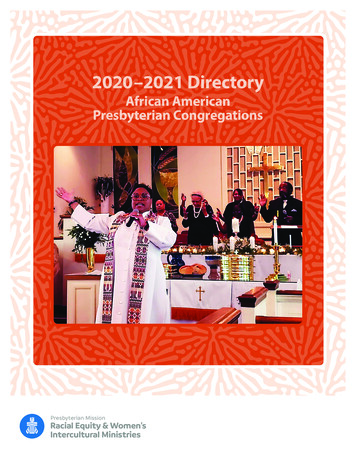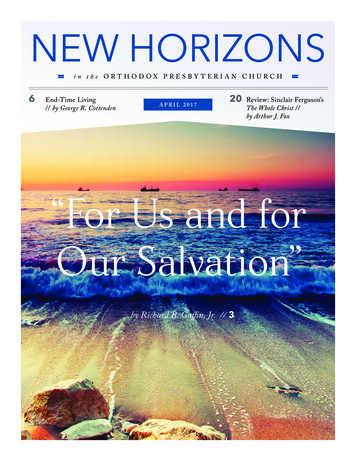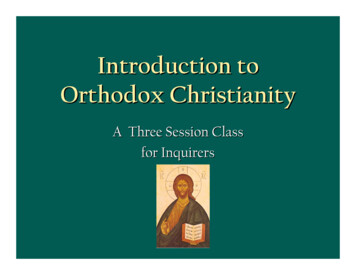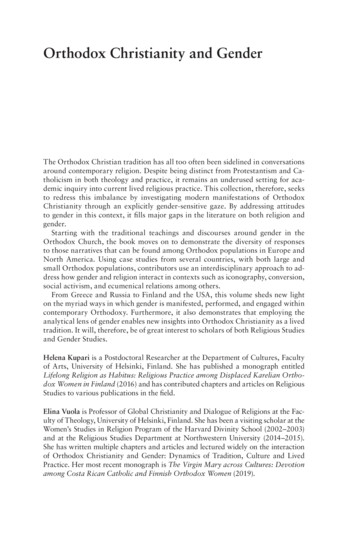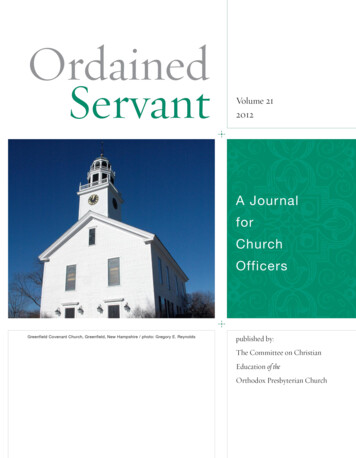
Transcription
OrdainedServantA Journal for Church OfficersVOLUME 21, 2012
Ordained ServantA Journal for Church OfficersA publication of the Committee on Christian Educationof the Orthodox Presbyterian ChurchISSN 1525-3503Volume 21 2012Editor: Gregory Edward Reynolds 827 Chestnut Street Manchester, NH 03104Telephone: 603-668-3069 Electronic mail: reynolds.1@opc.orgWebsite: www.opc.org/os.htmlOrdained Servant is published monthly online (except for combined issues June/July and August/September)(E-ISSN 1931-7115, online edition); and printed annually (ISSN: 1525-3503) after the end of each calendar year,beginning with volume 15 (2006) published in 2007. Ordained Servant was published quarterly in print from 1992through 2005. All 53 issues are available in our online archives. The editorial board is the Subcommittee on SerialPublications of the Committee on Christian Education.Subscriptions: Copies of the annual printed edition of Ordained Servant are sent to each ordained minister of theOrthodox Presbyterian Church, each organized congregation, and each designated mission work, and are paidfor by the Committee. Ordained elders, deacons, and licentiates of the Orthodox Presbyterian Church may receivecopies gratis upon request. Ordained Servant is also available to anyone in the U.S. and Canada who wishes tosubscribe by remitting 10.00 per year to: Ordained Servant, The Orthodox Presbyterian Church, 607 N. EastonRd., Bldg. E, Willow Grove, PA 19090-2539. Checks should be made out to the Orthodox Presbyterian Church,designated for Ordained Servant in the memo line. Foreign and institutional subscribers please remit 15.00 peryear. All remittances should be made payable in U.S. funds.Submissions: Chosen submissions will be published on the web and possibly chosen for the annual print edition.Please consult “Submissions, Style Guide, and Citations” on our website.Copyright Information: All material in this periodical is subject to U.S. and international copyright laws and maynot be reproduced without prior written approval. Please refer to “Submissions, Style Guide, and Citations” at ourwebsite once you have received permission. Interested parties are invited to obtain permission to reproduce material found in this publication by writing to the editor. Copyright 2012 by the Committee on Christian Education of the Orthodox Presbyterian Church.All rights reserved.
OrdainedServantA JOURNAL FOR CHURCH OFFICERSDedicated to John Patton GalbraithCONTENTS5From the EditorServantTraining41“How Much Catechesis? The Case fora Maximalist Approach to MembershipClasses,” Ken Golden45“Why a Candidates and CredentialsConference?” James S. GidleyServantThoughts52“How to Prepare Spiritually for OrdinationExams,” Ryan M. McGraw12“A Little Exercise for Young Theologians”14“Education, Natural Law, and the TwoKingdoms”ServantLiving18“The Value of Daydreaming”20“Face-to-Face: The Importance of PersonalPresence in Ministry and Life”ServantTribute6“A Tribute: The Rev. John Galbraith, Mr.OPC,” William ShishkoEDITORIALSServantWorship2757“Marks of a Faithful Church Member,” JoelR. BeekeServantHistory63“Calvin’s Kline,” David W. Inks69“The Revised Historiography of ReformedOrthodoxy: A Few Practical Implications,”Carl Trueman“Giving Thanks—The Neglected Prayer,”Jeffrey B. WilsonServantTruthServantLiterature32“Natural Law in Reformed Theology:Historical Reflections and BiblicalSuggestions,” David VanDrunen7537“ ‘Thou Art the Christ’: Reflections on theName of the Lord,” Bryan D. Holstrom“Why Read Literature?” Leland RykenServantEducation81“Geneva College and the OrthodoxPresbyterian Church,” Robert Tarullo85“The Education of a Monster,” James S.Gidley
91“Steering a Course betweenFundamentalism and Transformationalism:J. Gresham Machen’s View of Christian Scholarship,” Dariusz Brycko129“Faith and Reason,” review of RedeemingScience: A God-Centered Approach by Vern S.Poythress, Stephen A. Migotsky133“Words Made Flesh and Fresh,” review ofWords Made Fresh: Essays on Literatureand Culture by Larry Woiwode, Danny E.Olinger138“Life’s Complications and the Limitsof Expertise,” review of The Anointed:Evangelical Truth in a Secular Age byRandall J. Stephens and Karl W. Giberson,Darryl G. Hart140“Biblical Theology,” review of A NewTestament Biblical Theology by G. K. Beale,Wayne K. Forkner145“Faith in Politics,” review of Left, Right &Christ: Evangelical Faith in Politics by LisaSharon Harper and D. C. Innes, Richard M.Gamble148“The Reading and Preaching of theScriptures, Part 1,” review of The Readingand Preaching of the Scriptures in theWorship of the Christian Church by HughesOliphant Old, Dennis E. Johnson153“Bonhoeffer: Who’s Hero?” review ofBonhoeffer: Pastor, Martyr, Prophet, Spy byEric Mataxas, Gregory E. Reynolds158“Union with Christ,” review of Union withChrist: In Scripture, History, and Theologyby Robert Letham and Union with Christ:Reframing Theology and Ministry for theChurch, by J. Todd Billings, John V. Fesko165“Keeping Up with the Times: Evangelicalsand the New Media, Part 1,” review ofUnderstanding Evangelical Media: TheChanging Face of Christian Communicationedited by Quentin J. Schultze and RobertH. Woods Jr.; The New Media Frontier:Blogging, Vlogging, and Podcasting for Christedited by John Mark Reynolds and RogerOverton; Prophetically Incorrect: A ChristianIntroduction to Media Criticism by RobertH. Woods Jr. and Paul D. Patton, Gregory E.Reynolds168“Is This ‘a Holy Experience’ or a CommonOne?” review of One Thousand Gifts: A Dareto Live Fully Right Where You Are by AnnVoskamp, Andy WilsonServantHumorFrom the Back Pew102“Performance Sports,” Eutychus IIServantReadingBOOK REVIEWS104Miss Betsey: A Memoir of Marriage byEugene Genovese, Charles M. Wingard105Prayers of the Bible: Equipping Womento Call on God in Truth by Susan Hunt,Cynthia Rowland107Pastors in the Classics: Timeless Lessons onLife and Ministry from World Literatureby Leland Ryken, Philip Ryken, and ToddWilson, Gregory E. Reynolds108Lit! A Christian Guide to Reading Books byTony Reinke, Diane L. Olinger110A Vision for the Aging Church: RenewingMinistry for and by Seniors by James M.Houston and Michael Parker, Ross W.Graham112Ten Myths about Calvinism: Recoveringthe Breadth of the Reformed Tradition byKenneth J. Stewart, Darryl G. HartServantReadingREVIEW ARTICLES115“Confident of Better Things,” reviewof Confident of Better Things: EssaysCommemorating Seventy-five Years of theOrthodox Presbyterian Church edited by JohnR. Muether and Danny E. Olinger, WayneSparkman120“The Joy and Work of Prayer,” reviewof Prayer by Ole Hallesby, translated byClarence J. Carlsen, Alan D. Strange124“Spiritual Theology,” review of SpiritualTheology: A Systematic Study of the ChristianLife by Simon Chan, Alan D. Strange
From the EditorThis is the seventh annual printed edition of Ordained Servantas we enter the twenty-second year of publication.I have dedicated this annual edition to one of my favoritechurchmen, and a model of Christian leadership, John Patton Galbraith. His care for doing things decently and in order has helpeddiscipline several generations of ministers to be better Presbyterians.His presence of mind on the floor of general assemblies has keptmore than one debate on track. His love for Christ and his churchhas been exemplified in the many arenas in which he has served.The cover photo is of Greenfield Covenant Church in Greenfield, New Hampshire. It was founded in 1791 with twenty-eight members as the Church of Christ inGreenfield. New England is famous for having similar churches in each little town. These churches,closely associated with the life of the entire population, were essentially Reformed in theology andconnected regionally with something like a Presbyterian polity. Today few of these churches haveorthodox beliefs, but there are exceptions, one of which was featured on our cover in 2010 (vol. 19):Limington Congregational Church, which is now Limington Orthodox Presbyterian Church.It is my prayer that the pages of Ordained Servant will be used by our Lord to encourage, instruct, and motivate ministers of the Word, elders, and deacons to serve tirelessly to build the churchthroughout our world, however slim our resources, by trusting in the grace, power, and wisdom of theLord of the harvest, who has promised to be with his church to the end of the age.This year I have continued to print almost everything published online, because I have beenstricter about article length. I would like to thank the many fine writers who have worked with me torevise articles in order to stay within the prescribed limits.Once again I would like to thank general secretary Danny Olinger, Alan Strange, and the subcommittee of Darryl Hart, Sid Dyer, and Paul MacDonald, for their continued support, encouragement, and counsel. I would also like to thank the many people who make the regular online editionpossible: Diane Olinger, Linda Foh, Stephen Pribble, Andrew Moody, and the many fine writerswithout whom there would be no journal. Finally, I want to thank Ann Hart for her meticulous editorial work, and Jim Scott for his excellent formatting of the printed volume.—Gregory Edward ReynoldsAmoskeag Presbyterian ChurchManchester, New Hampshire
ServantTributeA Tribute: The Rev. JohnGalbraith, Mr. OPCOriginally published electronically in Ordained ServantOnline October 20121by William ShishkoOrdained Servant Volume 21 2012Those who are planted in the house of the LordShall flourish in the courts of our God.They shall still bear fruit in old age;They shall be fresh and flourishing,To declare that the Lord is upright;He is my rock, and there is no unrighteousness inHim.(Psalm 92:13–15 nkjv)6God willing, on March 10, 2013, the Rev. JohnGalbraith will celebrate his one hundredth birthday. How fitting that this will be a Sunday. Onthis day in which the church gathers to worshipGod and celebrate Christ’s conquest of death, theOrthodox Presbyterian Church’s oldest living minister will once again enter into the activity he lovesthe best: the praise of the Lord who is building hischurch!Of all of my prized associations with men andwomen of the Orthodox Presbyterian Church,none is prized more than my association with JohnGalbraith. To me and to so many others, he is Mr.OPC. I am honored to have been asked to writethis tribute to Mr. Galbraith—minister, husband,father (and grandfather and great grandfather!),church statesman, man of God, and (as he would1 http://www.opc.org/os.html?article id 324&issue id 78.point out first) sinner saved by grace.While John Galbraith is a product of America,his covenant lineage is Presbyterian. His fourgrandparents and both of his parents were of solidIrish Presbyterian stock. Both his father’s and hismother’s parents settled in Philadelphia, a Presbyterian center, when they moved to the USA fromIreland. His parents-to-be met at Oak Lane UnitedPresbyterian Church, a congregation that gathereda little south of Jenkintown. The Westminster Larger and Shorter Catechisms were important in thatcongregation (portions of the Larger Catechism aswell as the Shorter Catechism were memorized aspart of that church’s life).Following their marriage, John’s parentssettled in suburban Philadelphia, where theyattended the United Presbyterian Church in Wyncote. John was born in 1913. During his youth helearned of the controversy at Princeton Seminaryin nearby New Jersey. The name of J. GreshamMachen was familiar to him in his teenage years.The reorganization of Princeton Seminary and thesubsequent founding of Westminster Seminary in1929 occurred during John’s junior year of highschool.After his graduation in 1930, John attended aUnited Presbyterian school, Muskingum Collegein New Concord, Ohio. (At that time, John Glenn,the first American to orbit the earth, was a nineyear-old boy in New Concord. He, too, would laterattend and graduate from Muskingum College.)While his plan was to be a lawyer, that aspirationwould be changed very quickly. During a spiritualemphasis week in his freshman year at the college,John sensed a call to the Christian ministry. Majoring in English, minoring in Bible, and switchingfrom advanced classes in Latin to advanced classesin Greek, John pursued his studies avidly throughhis graduation in 1934. During that time he wasa member of a college club out of which manypursued the Christian ministry. He also faithfullyattended a local United Presbyterian Church.Given his family’s interest in the fundamentalist-modernist controversy and his familiarity withJ. Gresham Machen, it was inevitable that JohnGalbraith would attend Westminster Theological
town, Pennsylvania—what is now Calvary OPC,Glenside.On May 25, 1937, following his graduationfrom Westminster Seminary, John was ordainedby the Presbytery of Philadelphia. His first callwas to the Gethsemane congregation, a body insouthwest Philadelphia that had left the Presbyterian Church in the USA to become part of thethen Presbyterian Church of America. He servedthere until 1940, when he was called to GraceOPC in Westfield, New Jersey, a church foundedby Donald Graham, a Westminster classmate ofJohn’s, who had been ordained three days afterhim in the Presbytery of New Jersey. Two yearslater, he would be called to the OPC in Kirkwood,Pennsylvania, where he served as pastor until 1948.It was in that period that John would becomemore fully acquainted with the Orthodox Presbyterian Church as a whole. In 1940 and 1941 heserved as stated clerk of the general assembly ofthe OPC. From 1941 through 1948 he served onthe Committee on Home Missions and ChurchExtension (CHMCE) of the OPC. From 1944 to1945 he served on the Committee to Draw UpStanding Rules for the OPC. God was preparingJohn Galbraith for a long lifetime of service to thechurch body of which he was a part from the dayof its birth.In October 1948, John Galbraith was called toserve as general secretary of both the OPC Committee on Home Missions and Church Extensionand the OPC Committee on Foreign Missions.He would serve as general secretary of both committees until 1961. In that year he became thefirst full-time general secretary of the Committee on Foreign Missions. He would serve in thatrole through 1978. During those thirty years, hewas also an active participant on several of thecommittees that would help form the distinctivecharacter of the Orthodox Presbyterian Church:the Committee on Secret Societies (1946–50); theCommittee on Union with the Reformed Presbyterian Church, General Synod (1946–49); theCommittee on Revisions to the Form of Government (1948–77); and the Committee on ChristianEducation (1957–96), for which he also served asServant TributeSeminary. In the sixth year of the seminary’s life,1934, John entered Westminster. He was not disappointed with his choice, or with the experience ofthose years. For John, the school’s greatest strengthwas its faculty. Cornelius Van Til (whose outspoken zeal and passion particularly influenced John),R. B. Kuiper (whose preaching skills left a lastinginfluence), and J. Gresham Machen himself wereamong his professors. While Robert Dick Wilsonhad died the year before John entered seminary,he was still privileged to have learned from OswaldT. Allis, Ned Stonehouse, Paul Woolley, AllanMacRae, and the newest faculty member, JohnMurray, who joined the faculty the same year inwhich John entered Westminster as a student.John remembers the controversies that swirledaround the seminary in his final year, 1936–37.Premillennialism (the eschatological view heldby Professor MacRae), the desire for conservativePresbyterians to be more generally evangelical intheir expressions of faith (a view also espoused byProfessor MacRae), and the toleration of dispensationalism (a view held by none of the professorsat Westminster) were all hot topics of discussion inthat turbulent period. Throughout the first threeof his four seminary years, John attended TenthPresbyterian Church in Philadelphia—a congregation of the Presbyterian Church in the USA. Butthat would change in June 1936.On the afternoon of June 11, 1936, seminarian John Galbraith gathered with 139 other deeplyconcerned Presbyterians in the auditorium of theNew Century Club, at 124 South Twelfth Street,Philadelphia. Not only did he witness the beginning of what would become the Orthodox Presbyterian Church, but he was also among those whostood up, indicating his desire to be part of thatfaithful “true spiritual succession” of the Presbyterian Church in the USA. (His name, together withtwo other Galbraiths, is listed among the “laity”on page five of the minutes of the First GeneralAssembly of what was then called the PresbyterianChurch of America. John is fond of saying thatthere were more Galbraiths at that founding assembly than any other family group!) He promptlytook up membership in Calvary PCA, German-7
Volume 21 2012 Ordained Servant8chairman from 1955–56.In what could be considered a metaphor forthe demanding years of service John Galbraith rendered so selflessly for the Orthodox PresbyterianChurch, one of his first challenging duties was tovisit the family of young OPC missionary Florence Handyside, following her sudden death aftera very brief period of service in Korea. John droveto Rochester, New York, in a raging snowstorm, inorder to minister comfort to the grieving family.Though he was now in an administrative position,he did not lose the pastor’s heart that still marks hisministerial life.At the top of John’s recollections of thosemiddle years of the life of the now seventy-sixyear-old Orthodox Presbyterian Church was the“commitment to the OPC cause” that marked allof the standing committees of the OPC. “We allagreed on what we would present (to the church),and we would present it!” It was John’s idea tohave an annual Thank Offering for the work of theCommittees on Home Missions, Foreign Missions,and Christian Education. The OPC was hardly awealthy church. The Thank Offering to this day isa vehicle by which those committed to the work ofthe OPC can express their thanks for that work andgive to see it continued and expanded.According to John Galbraith, challenges inthe arena of the nations during the middle part ofthe twentieth century brought challenges, as well,to the OPC. It was during the General Assemblyof 1949 that he was on the phone with foreignmissionaries Egbert Andrews and Richard Gaffin,as Communists led by Mao Tse-tung began theirmarch to conquer China. The decision was madeto relocate our missionary labors to the island ofTaiwan. Likewise, though missionary ClarenceDuff desired to return to Ethiopia toward the endof World War II, at the invitation and urging ofthe British government the OPC began its laborsin Eritrea. As general secretary of both foreignand home missions, John Galbraith learned manytimes that “the mind of a man proposes, but theLord disposes” all things.A highlight of any Orthodox Presbyterianminister’s life is to be granted the honor of servingas moderator of the general assembly—a positionthat, by OPC tradition, is accorded to a man onlyonce. That honor was accorded to John Galbraithat the Fourteenth General Assembly, which metat Cedar Grove, Wisconsin in May 1947. JohnGalbraith, Floyd Hamilton (who had served asthe first-full time general secretary of Christianeducation since 1943), and Professor John Murrayof Westminster Seminary were all nominated tobe moderator of the assembly. Professor Murrayasked that his name be withdrawn. In what wouldbe a harbinger of things to come in that turbulentassembly, John Galbraith was elected over Hamilton—a man viewed by many of the commissionersas desiring an unwelcome “broad church” character for the OPC.It was during that assembly (after which manyof those who favored a broad evangelical coursefor the OPC left the church), that John Galbraithmade his mark as the ecclesiastical statesman hewould become. A heated floor debate had ensuedbetween Minister Clifford Smith and Dr. R. B.Kuiper, who was and continues to be revered byJohn Galbraith. That deep personal respect (and,no doubt, the sympathies he had with Kuiper’s position) did not prevent moderator Galbraith fromgaveling down the heated debaters. As moderator,he did his duty and told them both to apologizefor their conduct on the floor. They did. And JohnGalbraith established his reputation as a mangoverned by principle rather than by personality—something that has made an inestimable impacton the Orthodox Presbyterian Church.With his “retirement” as general secretary ofthe Committee on Foreign Missions in 1978 it wasas if then sixty-five-year-old John Galbraith began anew chapter in his life as an Orthodox Presbyterianminister. While he no longer had the challengingresponsibilities of general secretary, the generalassembly of the OPC would not let his experience, gifts, and wisdom lie fallow. Among otherduties, he would serve on the OPC Committee onPensions (a committee position to which he waselected beginning in 1964) until 1996 (a remarkable tenure of thirty-two years!), the Committeeon OPC Involvement in the Center for Urban
husband and father. He was married to Ada MaeKievitt on October 17, 1941, when he was servingas the young pastor of Grace OPC, Westfield, NewJersey. He and Ada would be blessed with fifty-twoyears of marriage and two daughters, Priscilla andSuzanne. His engagement and married life werewindows on the Christian (and very Presbyterian!)character of John Galbraith. The car and the wedding rings had to be paid for before their marriage!Any hard working married minister battleswith fulfilling the many-faceted duties of hisparticular ministerial call, while, at the same time,fulfilling his role as a husband and (when thereare children) a father. Given his duties as generalsecretary of both the OPC Committees on HomeMissions and Foreign Missions, John Galbraithwas often away from home. Ada, ever the helpersuitable to her husband’s needs, not only fulfilledhome responsibilities while John was away, butalso assisted with office duties connected with herhusband’s work. Later she would manage her ownreal estate business—which enabled her to findmany homes for Westminster Seminary students.(When he was home, John would often help Adaby putting “For Sale” signs on the properties forwhich she was responsible!)Living in Ardsley, Pennsylvania, some two tothree miles from both Calvary OPC in Glensideand nearby Westminster Seminary, afforded Johnand Ada the opportunity to get to know the students at what was, at that time, the seminary fromwhich the Orthodox Presbyterian Church got itsministers. Once a semester, John and Ada wouldopen their home on Friday and Saturday nights sothat all the Westminster seminarians could cometo their home for a “Hoagie Night.” John wantedto get to know each of the students, no doubt witha view of scouting out prospective pastors, homemissionaries, or foreign missionaries. John and Adaand their daughters were quite surprised on oneof these evenings when one of the seminarians atetwo huge hoagies. That student was a young mannamed Harvie Conn. Harvie would later becomean OPC missionary to Korea, and, following that,a professor at Westminster Seminary. Combinedwith this, traveling missionaries would regularlyServant TributeTheological Training from 1980–81, the Committee on Methods of Worldwide Outreach from1982–84, and the Committee on Ministerial Training from 1990–2005. He had previously served onthat committee from 1969–75, and also, in 1966,on a Special Committee to Study the Oversight ofMinisterial Candidates. To this day the training ofmen for ministry in the OPC remains one of hisgreat concerns and interests.John Galbraith’s decades of experience withinternational matters in the sphere of foreign missions would also be put to ample use in his years ofservice to various aspects of the OPC’s ecumenicallabors. From 1971–2002 he served on the OPCCommittee on Ecumenicity and InterchurchRelations (for which he served as chairman from1980–1984); and from 1964 through 1996 (again,another amazing tenure of over thirty years!) heserved as the OPC’s missions correspondent to theReformed Ecumenical Synod (RES), and he alsoserved as a delegate to the Reformed EcumenicalSynod in the years 1963, 1968, 1972, 1976, 1980,and 1984. He was given the honor of serving assecond clerk to the RES from 1968–72, first clerkfrom 1972–76, and moderator of the RES from1976–80, 1980–84, and 1984–88. During thistime he served on the OPC’s Committee on RESMatters (1973–88), a committee he chaired from1973–74, and 1980–88.Ecumenicity on the national level also occupied his attention as he served on the Committee to Confer with the Christian ReformedChurch (CRC) from 1967–73, and as chairman ofthe North American Presbyterian and ReformedCouncil (NAPARC) from 1976–77 and 1984–85.From Mr. Galbraith dozens of Reformed andPresbyterian church bodies from around the worldlearned of the Orthodox Presbyterian Church. Itwas fitting that John Galbraith authored the article“The Ecumenical Vision of the OPC” for thesemi-centennial volume of essays in honor of theOrthodox Presbyterian Church, Pressing Towardthe Mark, published in 1986.All of this emphasis on John Galbraith’s remarkable years of service to the Orthodox Presbyterian Church should not eclipse his life as a faithful9
Volume 21 2012 Ordained Servant10find lodging at the Galbraith home—a model ofChristian hospitality.John Galbraith’s busy life would never be soharried that it prevented him (and his family) fromenjoying the lawful pleasures of this life. Ever abaseball fan (the Philadelphia Phillies, of course),he would hurry home to watch baseball gameswhen he was able. When he would take the girls tothe games, he made them promise that they wouldwatch the game and also fill in their scorecards—with the correct scorecard shorthand! And, for amonth of summer vacation, Owl’s Head, Maine,became the family get-away. There John and hisfamily enjoyed the relaxation and change of pacethat is so necessary for those engaged in demanding Christian service. No doubt the commitmentto get a break from the labors of the ministry contributed much to John’s longevity in the work.As a committed family man, John fulfilled thevows he had taken both to his wife in marriage,and at the time of the baptism of his children. Aborn teacher, from his children’s earliest years, hetaught them the things of God. Marian Schoolland’s Big Book of Bible Stories among other bookswere staples of the Galbraith family’s Christiannurture. Thankfulness for the blessings of Godmarked their home. To this day, John is eminentlya man full of appreciation for everything that hisFather in heaven gives to him. He also beautifullydemonstrated the heart of a servant—the primarymark of a minister. On the Saturday nights hewas not away, he would get down on his handsand knees to wash the kitchen floor—giving Adaa break while she did other chores necessary to prepare the home for the upcoming Lord’s Day.John’s beloved help-meet departed this life onJuly 5, 1994. It was painful not to see John walkinghand-in-hand with Ada, especially during generalassemblies—which they often attended together inAda’s later years. One of the most moving personalmoments at an OPC general assembly was whenJohn gave thanks for both his wife of fifty-two years,and for the gift of God that she was to him. Tearfully, he also thanked God for the divine comfortgranted him following her death, and for how themuch felt absence of his wife nevertheless wasworking to his sanctification by a specially feltsense of the presence of the Lord with him. JohnGalbraith, the church statesman, was, and remainsto this day, a man who upholds the grace, goodness, love, and faithfulness of our covenant God.In these latter years of John Galbraith’s life,he continues to reside at Rydal Park, in Rydal,Pennsylvania—just a few miles north of 7401 OldYork Road, the location of the OPC administrative offices in which John’s presence was felt for somany years, and just a few miles south of the current OPC administrative offices. He remains verymuch interested in everything transpiring in thelife of the Orthodox Presbyterian Church—andhis disciplined, organized mind has lost little of itsability to recall the facts, personalities, and eventsthat have formed the character of the churchwhich he so much loves.When asked the highlights of his threequarters of a century as an Orthodox Presbyterianminister, John responded by saying, “They beganwhen I became one!” He has no regrets about thatdecision. He was glad that he wrote the bookletWhy the Orthodox Presbyterian Church? whichfirst appeared in 1940. It was his way of giving a“message for the world” regarding “what we wereabout.” “The course of the OPC was set in thesecond and third general assemblies,” John notes.“Our commitments to the Bible and to Christianliberty” are and remain the hallmarks of the OPC.And what message does John Galbraith wantto communicate to the OPC as he approaches hisone hundredth birthday? Ever the preacher, he hasthree points:The first is the importance of worship. Johnnotes that the command to honor the Sabbathday (and it is a command!) is a critical transitionfrom the first three “God-ward” commandments,and the last six “man-ward” commandments. Heis deeply concerned about the growing laxity in attendance at a second worship service on the Lord’sDay, or—even worse—the tendency to eliminatethat service altogether. “The Sabbath gives us awhole day for fellowship with God and with hispeople. It’s a day for us to grow in our knowledgeof the Scriptures. Why would any Christian want
Additional ResourcesArticles “Choose Ye This Day! An Analysis of the Reasons Why Christians Should Separate from thePresbyterian Church in the USA,” http://www.opc.org/cce/choose ye.html. “Why the Orthodox Presbyterian s The Committee on Christian Education Presentati
A publication of the Committee on Christian Education of the Orthodox Presbyterian Church ISSN 1525-3503 Volume 21 2012 . to Call on God in Truth by Susan Hunt, Cynthia Rowland 107 Pastors in the Classics: . none is prized more than my association with John Galbraith. To me and to so many others, he is Mr.
